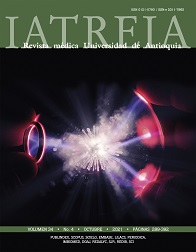Translation, cultural adaptation and validity of content and construct of “Feedback-Provider in Medical Education” questionnaire in medical students
DOI:
https://doi.org/10.17533/10.17533/udea.iatreia.117Keywords:
factor analysis, statistical, surveys and questionnaires, students medical, internship and residencyAbstract
Introduction: The Feedback in Medical Education questionnaire (FEEDME-Provider) is an instrument that measures the interaction between the medical student or resident with the doctor who provides the eedback.
Objectives: This study aims to translate and culturally adapt the FEEDME-Provider questionnaire to Latin American Spanish and evaluate its internal consistency and validity of content and structural construct.
Methods: An instrumental analytical observational study was carried out on 139 medical students. The scale validity was determined through Aiken V coefficient and its 95% confidence intervals. In addition, factor analysis and reliability tests were carried out.
Results: All Aiken V coefficient values were statistically significant (V > 0,70) with appropriate 95% CI lower imit values. The asymmetry and kurtosis of the items were less than ± 1.5. The exploratory factor analysis evealed the existence of 3 factors, which correspond to the theoretical structure of the original scale. All the items presented saturation values > 0.30. However, items 1 and 3 were eliminated because they did not correspond theoretically to their factor. Regarding the reliability of the total scale and its factors, Cronbach’s α coefficient is greater than 0.80, which indicates that the scale has internal consistency.
Conclusions: The appropriate translation and cultural adjustments of some items resulted in consistent psychometric properties (reliability and validity of content and structural construct) of the FEEDME-Provider Scale scores in a sample of Peruvian medical students.
Downloads
References
(1) Ende J. Feedback in clinical medical education. Jama. 1983;250(6):777-81.
(2) Alhaqwi AI. Importance and process of feedback in undergraduate medical education in Saudi Arabia. Saudi J Kidney Dis Transpl. 2012;23(5):1051-5. DOI 10.4103/1319-2442.100949.
(3) Georgoff PE, Shaughness G, Leininger L, Nikolian VC, Sandhu G, Reddy R, et al. Evaluating the performance of the Minute Feedback System: A webbased feedback tool for medical students. Am J Surg. 2018;215(2):293-7. DOI 10.1016/j.amjsurg.2017.08.047.
(4) Richman PS, Olvet DM, Ahmad S, Chandran L. Use of student feedback to drive quality improvement (QI) in a preclinical U.S. medical school course. Med Educ Online. 2019;24(1):1583968. DOI 10.1080/10872981.2019.1583968.
(5) Prince KJ, Van De Wiel M, Scherpbier AJ, Can Der Vleuten CP, Boshuizen HP. A Qualitative Analysis of the Transition from Theory to Practice in Undergraduate Training in a PBL-Medical School. Adv Health Sci Educ Theory Pract. 2000;5(2):105-16. DOI 10.1023/A:1009873003677.
(6) Al-Mously N, Nabil NM, Al-Babtain SA, Fouad Abbas MA. Undergraduate medical students’ perceptions on the quality of feedback received during clinical rotations. Med Teach. 2014;36 Suppl 1:S17-23. DOI 10.3109/0142159X.2014.886009.
(7) Hughes DT, Leininger L, Reddy RM, Sandhu G, Ryszawa S, Englesbe M. A novel Minute Feedback System for medical students. Am J Surg. 2017;213(2):330-5. DOI 10.1016/j.amjsurg.2016.11.042.
(8) Bowen L, Marshall M, Murdoch-Eaton D. Medical Student Perceptions of Feedback and Feedback Behaviors Within the Context of the “Educational Alliance”. Acad Med. 2017;92(9):1303-12. DOI 10.1097/ACM.0000000000001632.
(9) Bing-You RG, Trowbridge RL. Why medical educators may be failing at feedback. Jama. 2009;302(12):1330-1. DOI 10.1001/jama.2009.1393.
(10) Bing-You R, Ramesh S, Hayes V, Varaklis K, Ward D, Blanco M. Trainees’ Perceptions of Feedback: Validity Evidence for Two FEEDME (Feedback in Medical Education) Instruments. Teach Learn Med. 2018;30(2):162-72. DOI 10.1080/10401334.2017.1392863.
(11) Guillemin F, Bombardier C, Beaton D. Cross-cultural adaptation of health-related quality of life measures: literature review and proposed guidelines. J Clin Epidemiol. 1993;46(12):1417-32. DOI 10.1016/0895-4356(93)90142-n.
(12) Fornells JM, Julià X, Arnau J, Martínez-Carretero JM. Feedback en educación médica. Educación Médica. 2008;11:7-12.
(13) Merenda PF. An overview of adapting educational and psychological assessment instruments: past and present. Psychol Rep. 2006;99(2):307-14. DOI 10.2466/pr0.99.2.307-314.
(14) Bolaños-Medina A, González-Ruiz V. Deconstructing the Translation of Psychological Tests. Meta. 2012;57(3):715-39. DOI 10.7202/1017088ar.
(15) Jeanrie C, Bertrand R. Translating tests with the International Test Commission’s guidelines: Keeping validity in mind. European Journal of Psychological Assessment. 1999;15(3):277-83. DOI 10.1027/1015-5759.15.3.277.
(16) Adjakossa EH, Sadissou I, Hounkonnou MN, Nuel G. Multivariate Longitudinal Analysis with Bivariate Correlation Test. PLoS One. 2016;11(8):e0159649. DOI 10.1371/journal.pone.0159649.
(17) Bing-You R, Ramani S, Ramesh S, Hayes V, Varaklis K, Ward D, et al. The interplay between residency program culture and feedback culture: a cross-sectional study exploring perceptions of residents at three institutions. Med Educ Online. 2019;24(1):1611296. DOI 10.1080/10872981.2019.1611296.
(18) Cortina JM. What is coefficient alpha? An examination of theory and applications. Journal of Applied Psychology. 1993;78(1):98-104. DOI 10.1037/0021-9010.78.1.98.
(19) Taber KS. The Use of Cronbach’s Alpha When Developing and Reporting Research Instruments in Science Education. Research in Science Education. 2018;48(6):1273-96. DOI 10.1007/s11165-016-9602-2.
(20) Leenen I. Virtudes y limitaciones de la teoría de respuesta al ítem para la evaluación educativa en las ciencias médicas. Investigación en Educación Médica. 2014;3(9):40-55. DOI 10.1016/S2007-5057(14)72724-3.
(21) Putnick DL, Bornstein MH. Measurement Invariance Conventions and Reporting: The State of the Art and Future Directions for Psychological Research. Dev Rev. 2016;41:71-90. DOI 10.1016/j.dr.2016.06.004.
(22) Ventura-León J, Caycho-Rodríguez T, Dominguez-Lara S. Invarianza Factorial Según Sexo de la Basic Empathy Scale Abreviada en Adolescentes Peruanos. Psykhe (Santiago). 2019;28:1-11. DOI 10.7764/psykhe.28.2.1418.
Additional Files
Published
How to Cite
Issue
Section
License
Copyright (c) 2021 Universidad de Antioquia

This work is licensed under a Creative Commons Attribution-NonCommercial-ShareAlike 4.0 International License.
Papers published in the journal are available for use under the Creative Commons license, specifically Attribution-NonCommercial-ShareAlike 4.0 International.
The papers must be unpublished and sent exclusively to the Journal Iatreia; the author uploading the contribution is required to submit two fully completed formats: article submission and authorship responsibility.














